Pilot Assistance Systems for Energy-Optimized Approaches: Is It Possible to Reduce Fuel Consumption and Noise at the Same Time?
Abstract
1. Introduction
[…] noise resulting from a departure can only be redistributed in the airport environment. However, approach procedures offer an additional real noise reduction potential because the force of gravity supports the descent process. Taking advantage of this and minimizing aerodynamic drag can result in local noise reductions of 5 dB or more compared to standard approach procedures.
For an aircraft to descend from cruise altitude to touchdown with the lowest possible fuel consumption and noise signature, an approach is required that is both at idle thrust in the ideal speed and follows an ideal vertical profile without using speed brakes, extending the landing gear too early, or flying unnecessary level segments with high thrust settings.
2. Methods
2.1. Test Scenario and Description of Flights
2.2. Fuel Consumption
2.3. Noise
3. Results
3.1. Fuel Consumption
3.2. Noise
3.3. Combined Analysis of Fuel Consumption and Noise
4. Discussion
5. Conclusions and Outlook
It will take incorporation of flight, airspace, and ATC procedure changes and improvements in aircraft equipage on a wide-spread basis, adopted by the pilots, air carriers, air navigation service providers and airport operators for these benefits to be fully realized.
Author Contributions
Funding
Data Availability Statement
Acknowledgments
Conflicts of Interest
Abbreviations
| AAL | Above Airfield Level |
| ATC | Air Traffic Control |
| ATCo | Air Traffic Controller |
| CDA | Continuous Descent Approach |
| DYNCAT | Dynamic Configuration Adjustment in the TMA |
| FDR | Flight Data Recorder |
| FMS | Flight Management System |
| ICAO | International Civil Aviation Organization |
| LAE | A-weighted sound exposure level |
| LAS | A-weighted sound pressure level with time constant SLOW (1 s) |
| LNAS | Low-Noise Augmentation System |
| N1 | Rotational speed of the jet engine’s low pressure shaft |
| NM | Nautical Miles |
| TMA | Terminal Manoeuvring Area |
References
- Burgueño Salas, E. Environmental Impact of the Aviation Industry Worldwide-Statistics & Facts. 2022. Available online: http://publications.jrc.ec.europa.eu/repository/handle/111111111/26390 (accessed on 24 September 2013).
- Air Transport Action Group. Facts & Figures; Air Transport Action Group: Geneva, Switzerland, 2020. [Google Scholar]
- EUROCONTROL. EUROCONTROL Forecast Update 2023–2029; EUROCONTROL: Brussels, Belgium, 2023. [Google Scholar]
- de Hollander, A.E.M.; Melse, J.M.; Lebret, E.; Kramers, P.G.N. An aggregate public health indicator to represent the impact of multiple environmental exposures. Epidemiology 1999, 10, 606–617. [Google Scholar] [CrossRef]
- Sørensen, M.; Münzel, T.; Brink, M.; Roswall, N.; Wunderli, J.M.; Foraster, M. Chapter four—Transport, noise, and health. In Advances in Transportation and Health; Nieuwenhuijsen, M.J., Khreis, H., Eds.; Elsevier: New York, NY, USA, 2020; pp. 105–131. [Google Scholar] [CrossRef]
- WHO. Burden of Disease from Environmental Noise. Quantification of Healthy Life Years Lost in Europe; Report; World Health Organization (WHO) Regional Office for Europe: Copenhagen, Denmark, 2011; ISBN 978-92-890-0229-5.
- Friedt, F.L.; Cohen, J.P. Perception vs. reality: The aviation noise complaint effect on home prices. Transp. Res. Part D Transp. Environ. 2021, 100, 103011. [Google Scholar] [CrossRef]
- Kharina, A.; Rutherford, D. Fuel Efficiency Trends for New Commercial Jet Aircraft: 1960 to 2014; Report; International Council on Clean Transportation: Berlin, Germany, 2015. [Google Scholar]
- Kors, E.; Collin, D. Perspective on 25 Years of European Aircraft Noise Reduction Technology Efforts and Shift Towards Global Research Aimed at Quieter Air Transport. In Aviation Noise Impact Management: Technologies, Regulations, and Societal Well-Being in Europe; Leylekian, L., Covrig, A., Maximova, A., Eds.; Springer International Publishing: Cham, Switzerland, 2022; pp. 57–116. [Google Scholar] [CrossRef]
- Zellmann, C.; Schäffer, B.; Wunderli, J.M.; Isermann, U.; Paschereit, C.O. Aircraft Noise Emission Model Accounting for Aircraft Flight Parameters. J. Aircr. 2017, 55, 682–695. [Google Scholar] [CrossRef]
- ICAO (International Civil Aviation Organization). Review of Noise Abatement Procedure Research & Development and Implementation Results; Report; ICAO: Rio de Janeiro, Brazil, 2007. [Google Scholar]
- Isermann, U. Potentials and Limits of Noise Abatement Flight Procedures. In Proceedings of the Internoise 2013, Innsbruck, Austria, 15–18 September 2013. [Google Scholar]
- Kurz, J.; Blinstrup, J. Conceptual design of a pilot assistance system for customised noise abatement departure procedures. CEAS Aeronaut. J. 2023, 15, 325–337. [Google Scholar] [CrossRef]
- Christian, A.; Sparrow, V. A multi-objective evolutionary optimization approach to procedural flightnoise mitigation. Proc. Meet. Acoust. 2013, 19, 040073. [Google Scholar]
- Rodríguez-Díaz, A.; Adenso-Díaz, B.; González-Torre, P.L. Improving aircraft approach operations taking into account noise and fuel consumption. J. Air Transp. Manag. 2019, 77, 46–56. [Google Scholar] [CrossRef]
- Clarke, J.P.B.; Ho, N.T.; Ren, L.; Brown, J.A.; Elmer, K.R.; Tong, K.O.; Wat, J.K. Continuous Descent Approach: Design and Flight Test for Louisville International Airport. J. Aircr. 2004, 41, 1054–1066. [Google Scholar] [CrossRef]
- Jin, L.; Cao, Y.; Sun, D. Investigation of Potential Fuel Savings Due to Continuous-Descent Approach. J. Aircr. 2013, 50, 807–816. [Google Scholar] [CrossRef]
- Filippone, A. Options for aircraft noise reduction on arrival and landing. Aerosp. Sci. Technol. 2017, 60, 31–38. [Google Scholar] [CrossRef]
- Otero, E.; Tengzelius, U.; Moberg, B. Flight Procedure Analysis for a Combined Environmental Impact Reduction: An Optimal Trade-Off Strategy. Aerospace 2022, 9, 683. [Google Scholar] [CrossRef]
- Abdelmoula, F.; Roeser, M.S.; Kühne, C.G.; Gerber, M.; Wunderli, J.M. Impact of ATC speed instructions on fuel consumption and noise exposure: An assessment of real operations in Zurich. CEAS Aeronaut. J. 2022, 13, 1041–1053. [Google Scholar] [CrossRef]
- Gerber, M.; Schreiber, Y.; Abdelmoula, F.; Kühne, C.G.; Jäger, D.; Wunderli, J.M. Energy-optimized approaches: A challenge from the perspectives of pilots and air traffic controllers. CEAS Aeronaut. J. 2022, 13, 1055–1066. [Google Scholar] [CrossRef]
- Abdelmoula, F.; Scholz, M. LNAS—A pilot assistance system for low-noise approaches with minimal fuel consumption. In Proceedings of the 31st Congress of the International Council of the Aeronautical Sciences, Horizonte, Brazil, 9–14 September 2018. [Google Scholar]
- Jäger, D.; Zellmann, C.; Wunderli, J.M.; Scholz, M.; Abdelmoula, F.; Gerber, M. Validation of an airline pilot assistant system for low-noise approach procedures. Transp. Res. Part D Transp. Environ. 2021, 99, 103020. [Google Scholar] [CrossRef]
- Bauer, T.; Abdelmoula, F.; Boyer, J.; Gerber, M.; Meister, J.; Wunderli, J.M. Improved Configuration Management for Greener Approaches—Evaluation of a Novel Pilot Support Concept. In Proceedings of the ICAS 2022—33rd International Council of Aeronautical Sciences (ICAS), Stockholm, Sweden, 4–9 September 2022; Volume 9, pp. 6568–6583. [Google Scholar]
- Boyer, J.; Dacre-Wright, B. Permanent Resume Trajectory: An Innovative Flight Management System Functionality for Greener and Seamless Operations. In Proceedings of the Aerospace Europe Conference 2020, Bordeaux, France, 25–27 February 2020. [Google Scholar]
- Pauly, P.; Meister, J.; Wunderli, J.M.; Gerber, M.; Boyer, J.; Abdelmoula, F.; Bauer, T. Improved energy management during arrival for lower noise emissions. In Proceedings of the Towards Sustainable Aviation Summit (TSAS), Toulouse, France, 18–20 October 2022. Paper No. 16. [Google Scholar]
- Wunderli, J.M.; Rotach, M.W. Application of Statistical Weather Data From the Numerical Weather Prediction Model COSMO-2 for Noise Mapping Purposes. Acta Acust. United Acust. 2011, 97, 403–415. [Google Scholar] [CrossRef]
- Wunderli, J.M.; Zellmann, C.; Köpfli, M.; Habermacher, M.; Schwab, O.; Schlatter, F.; Schäffer, B. sonAIR—A GIS-Integrated Spectral Aircraft Noise Simulation Tool for Single Flight Prediction and Noise Mapping. Acta Acust. United Acust. 2018, 104, 440–451. [Google Scholar] [CrossRef]
- Jäger, D.; Zellmann, C.; Schlatter, F.; Wunderli, J.M. Validation of the sonAIR aircraft noise simulation model. Noise Mapp. 2020, 8, 95–107. [Google Scholar] [CrossRef]
- Meister, J.; Schalcher, S.; Wunderli, J.M.; Jäger, D.; Zellmann, C.; Schäffer, B. Comparison of the Aircraft Noise Calculation Programs sonAIR, FLULA2 and AEDT with Noise Measurements of Single Flights. Aerospace 2021, 8, 388. [Google Scholar] [CrossRef]
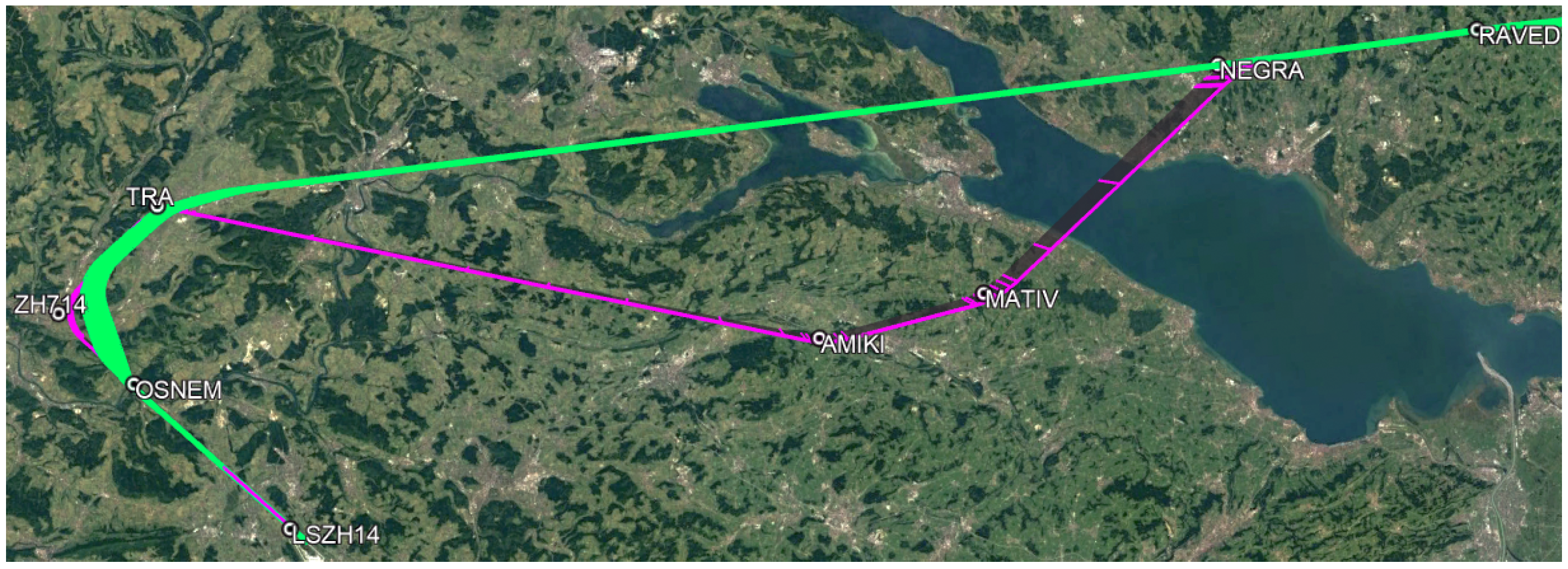
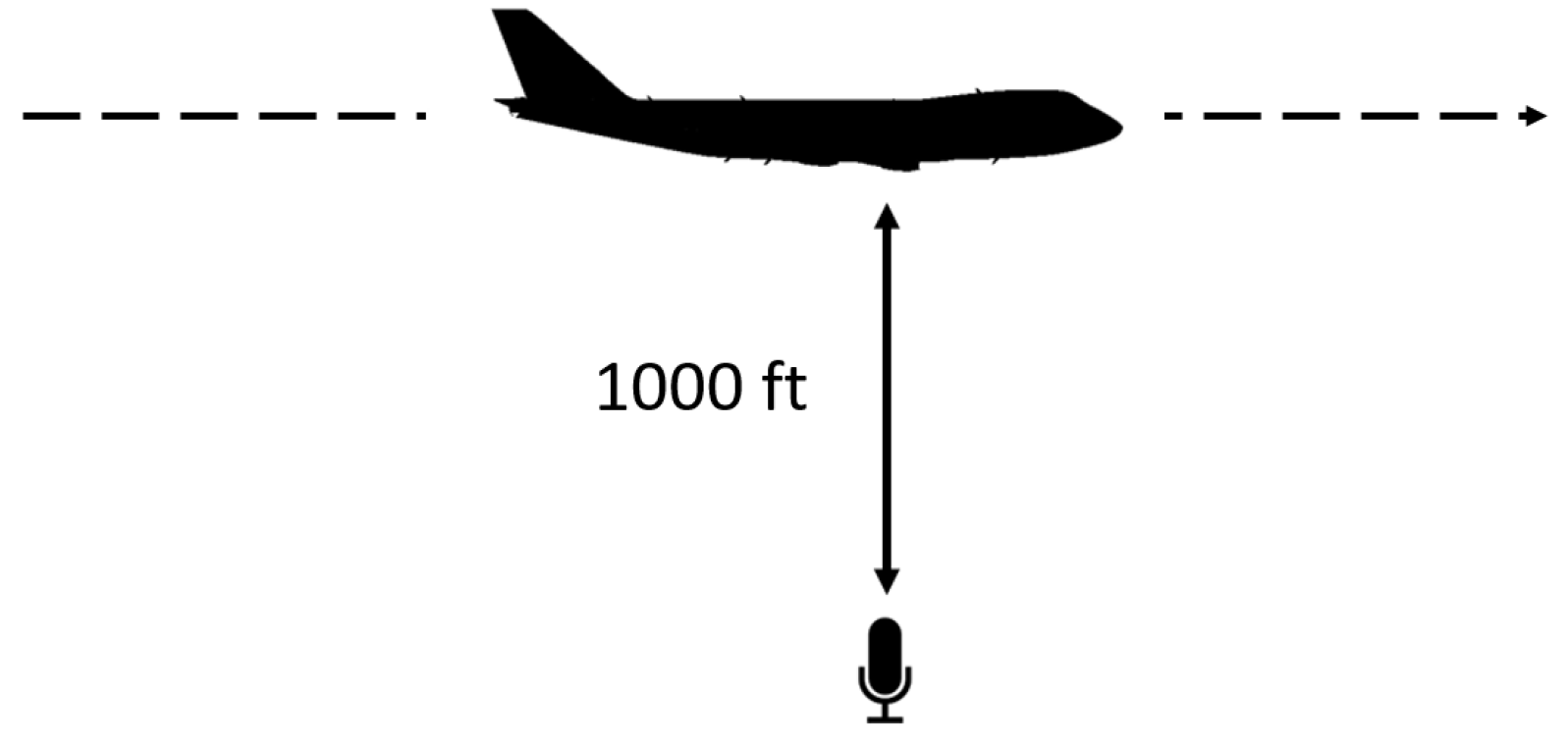
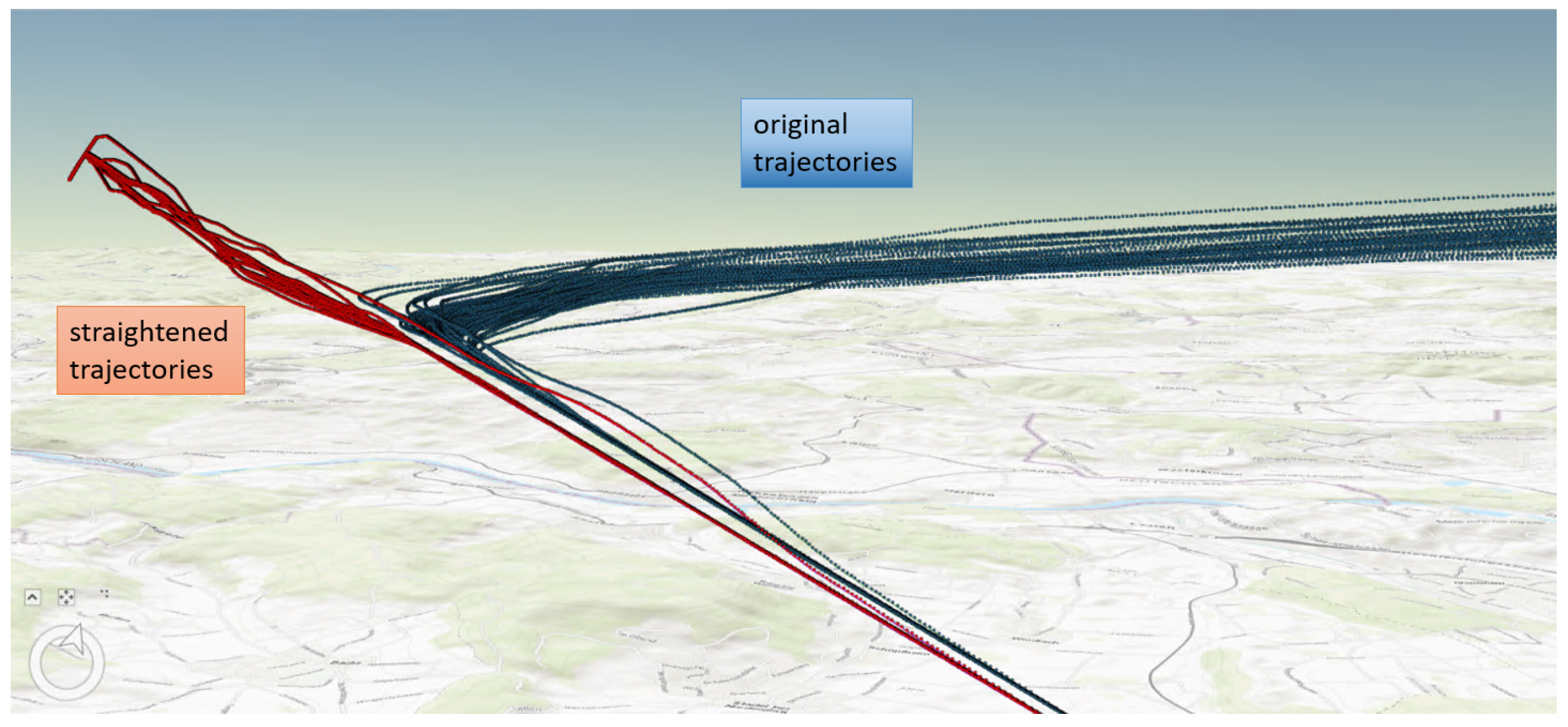
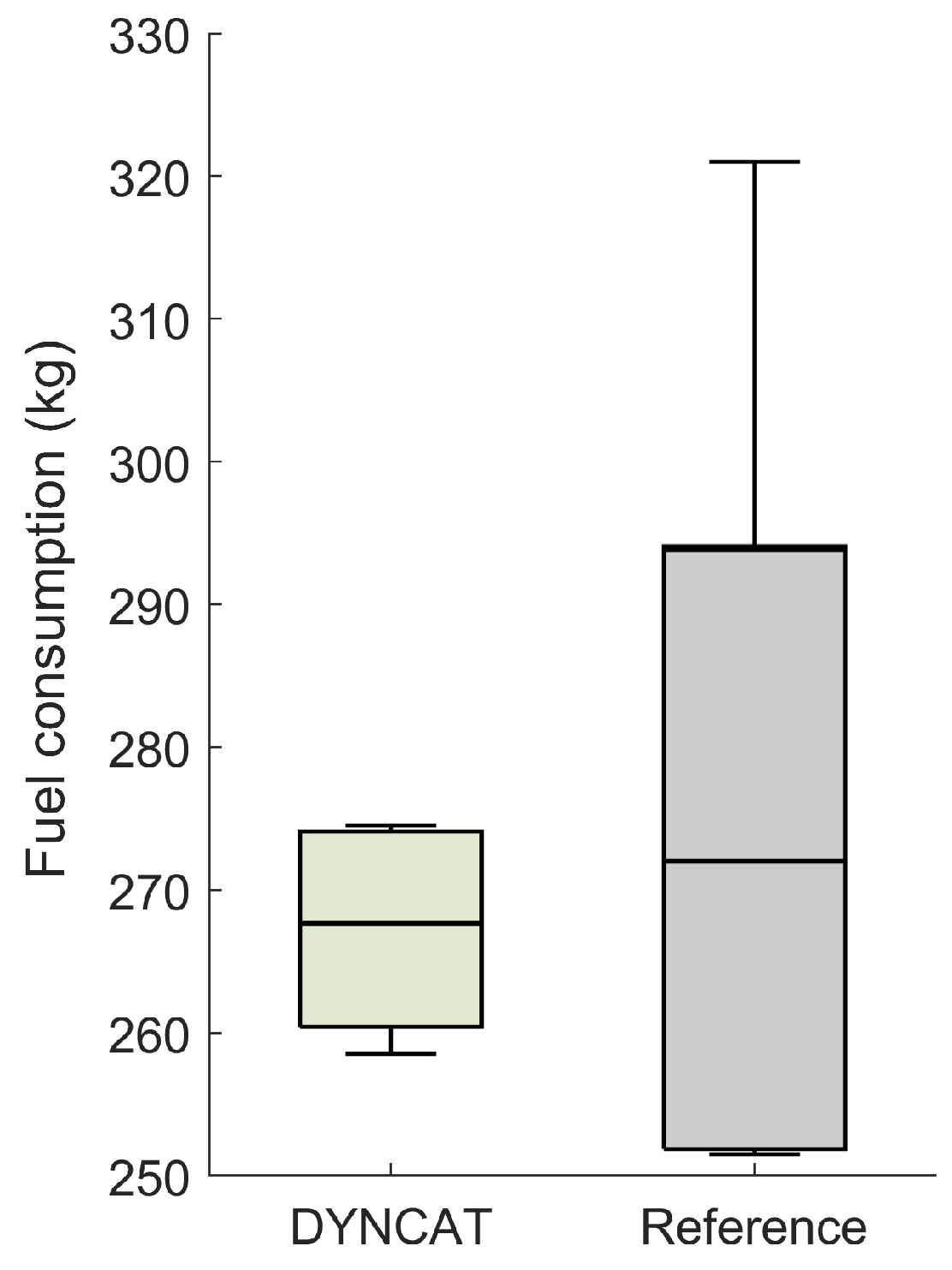
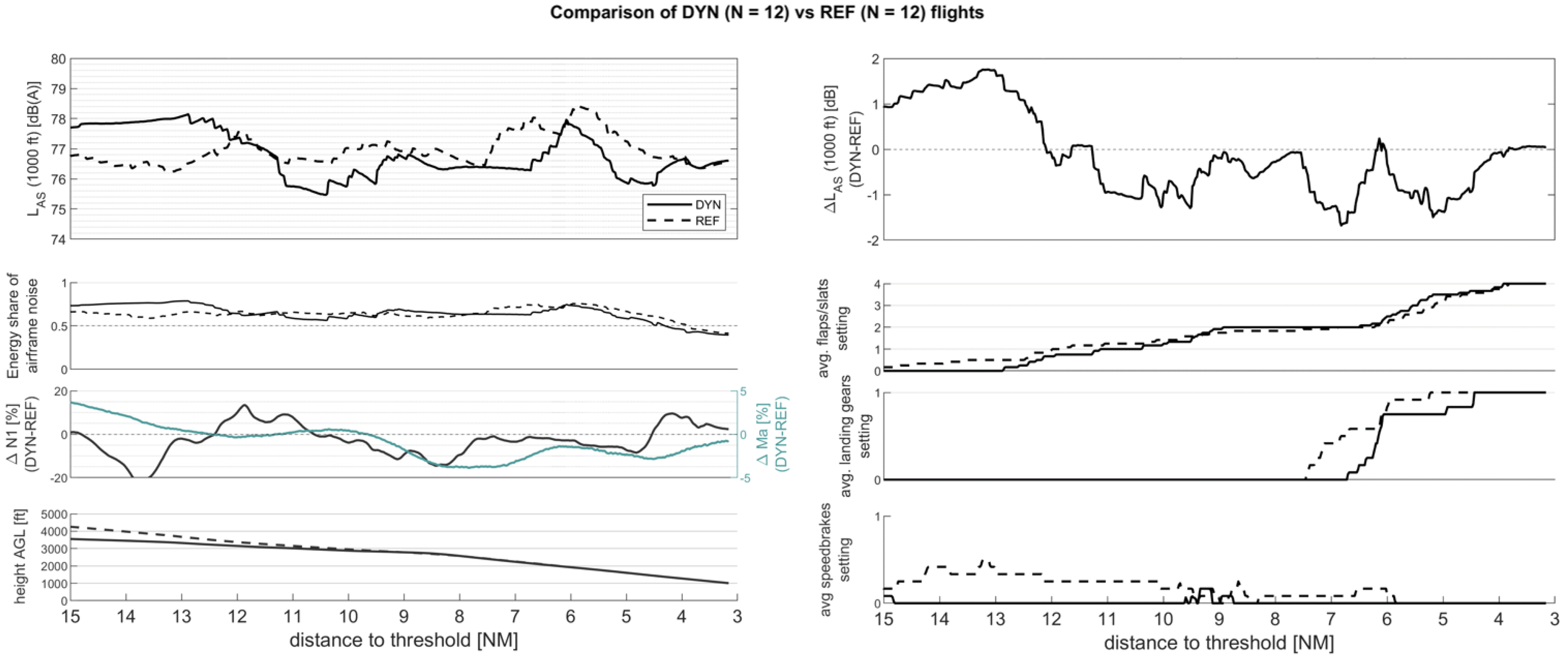
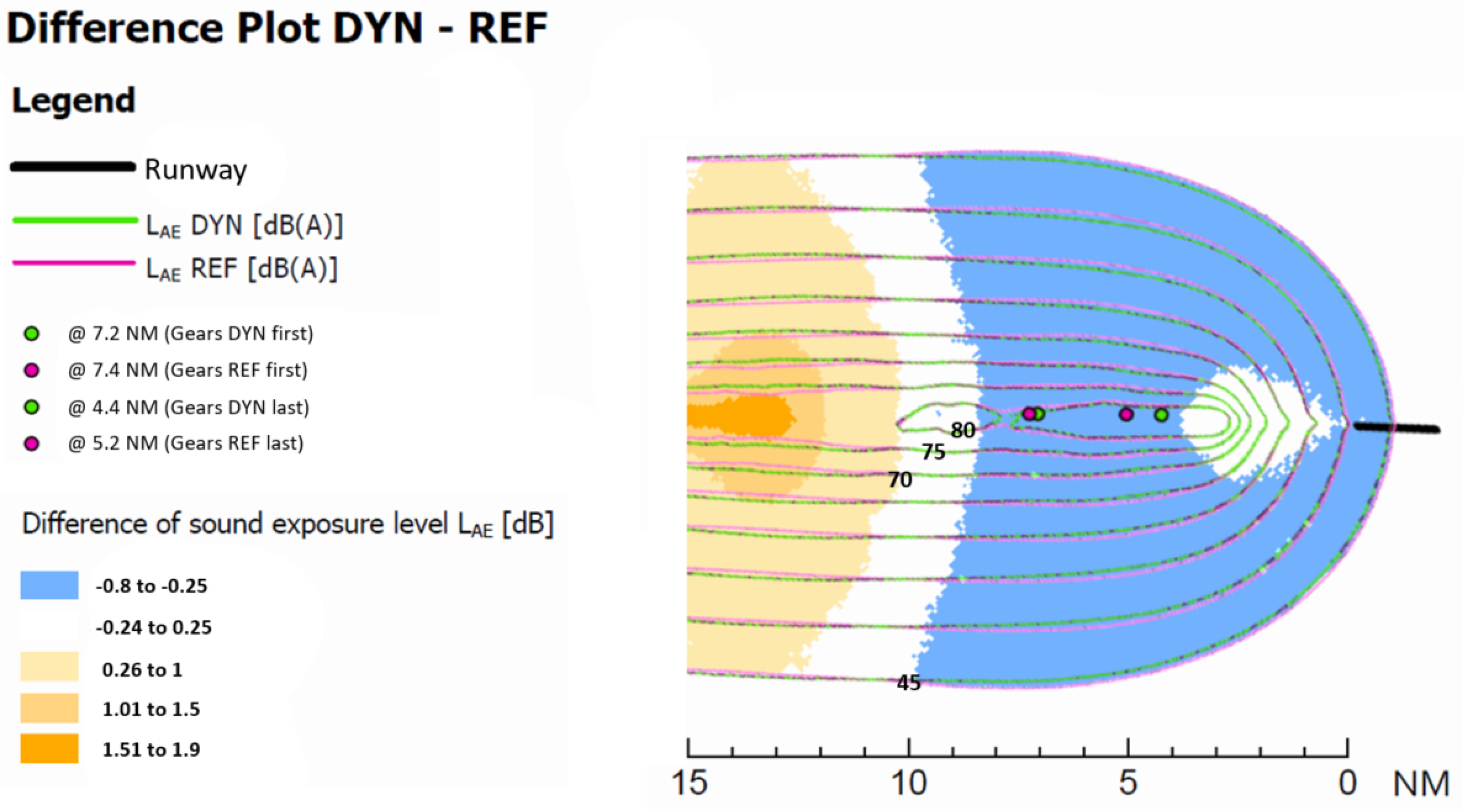
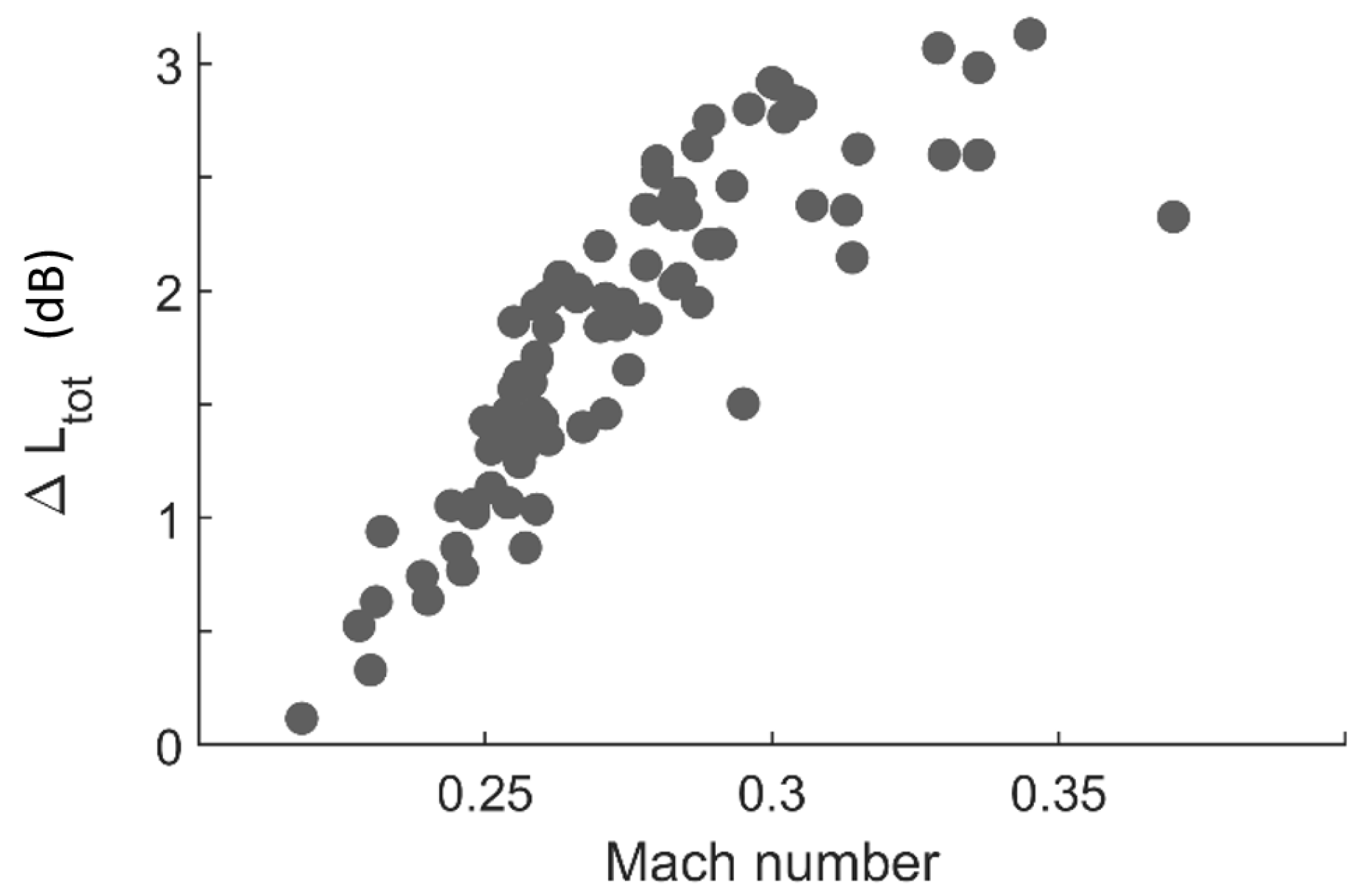
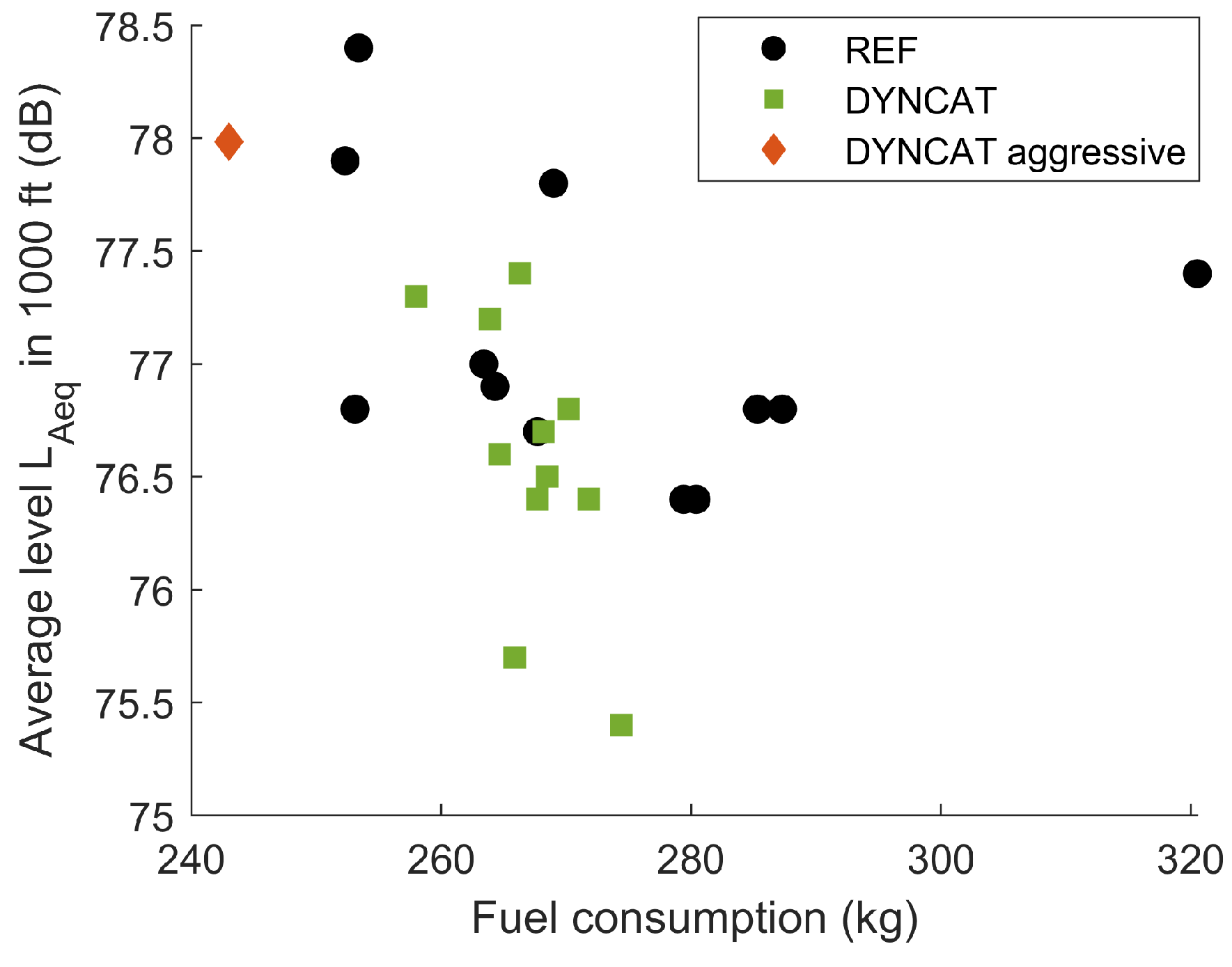
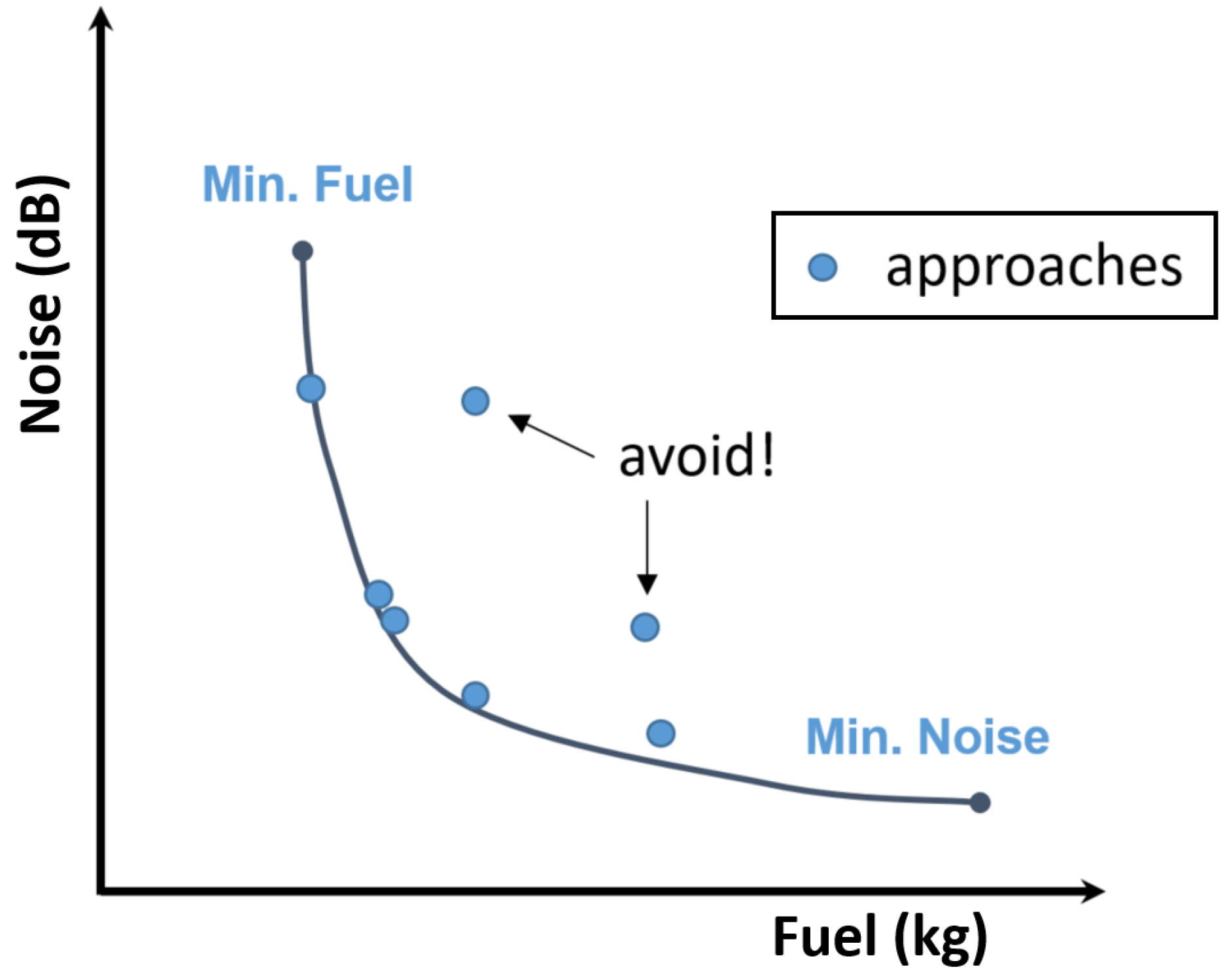
Disclaimer/Publisher’s Note: The statements, opinions and data contained in all publications are solely those of the individual author(s) and contributor(s) and not of MDPI and/or the editor(s). MDPI and/or the editor(s) disclaim responsibility for any injury to people or property resulting from any ideas, methods, instructions or products referred to in the content. |
© 2024 by the authors. Licensee MDPI, Basel, Switzerland. This article is an open access article distributed under the terms and conditions of the Creative Commons Attribution (CC BY) license (https://creativecommons.org/licenses/by/4.0/).
Share and Cite
Wunderli, J.M.; Meister, J.; Boyer, J.; Gerber, M.; Bauer, T.; Abdelmoula, F. Pilot Assistance Systems for Energy-Optimized Approaches: Is It Possible to Reduce Fuel Consumption and Noise at the Same Time? Aerospace 2024, 11, 450. https://doi.org/10.3390/aerospace11060450
Wunderli JM, Meister J, Boyer J, Gerber M, Bauer T, Abdelmoula F. Pilot Assistance Systems for Energy-Optimized Approaches: Is It Possible to Reduce Fuel Consumption and Noise at the Same Time? Aerospace. 2024; 11(6):450. https://doi.org/10.3390/aerospace11060450
Chicago/Turabian StyleWunderli, Jean Marc, Jonas Meister, Johan Boyer, Martin Gerber, Tobias Bauer, and Fethi Abdelmoula. 2024. "Pilot Assistance Systems for Energy-Optimized Approaches: Is It Possible to Reduce Fuel Consumption and Noise at the Same Time?" Aerospace 11, no. 6: 450. https://doi.org/10.3390/aerospace11060450
APA StyleWunderli, J. M., Meister, J., Boyer, J., Gerber, M., Bauer, T., & Abdelmoula, F. (2024). Pilot Assistance Systems for Energy-Optimized Approaches: Is It Possible to Reduce Fuel Consumption and Noise at the Same Time? Aerospace, 11(6), 450. https://doi.org/10.3390/aerospace11060450






